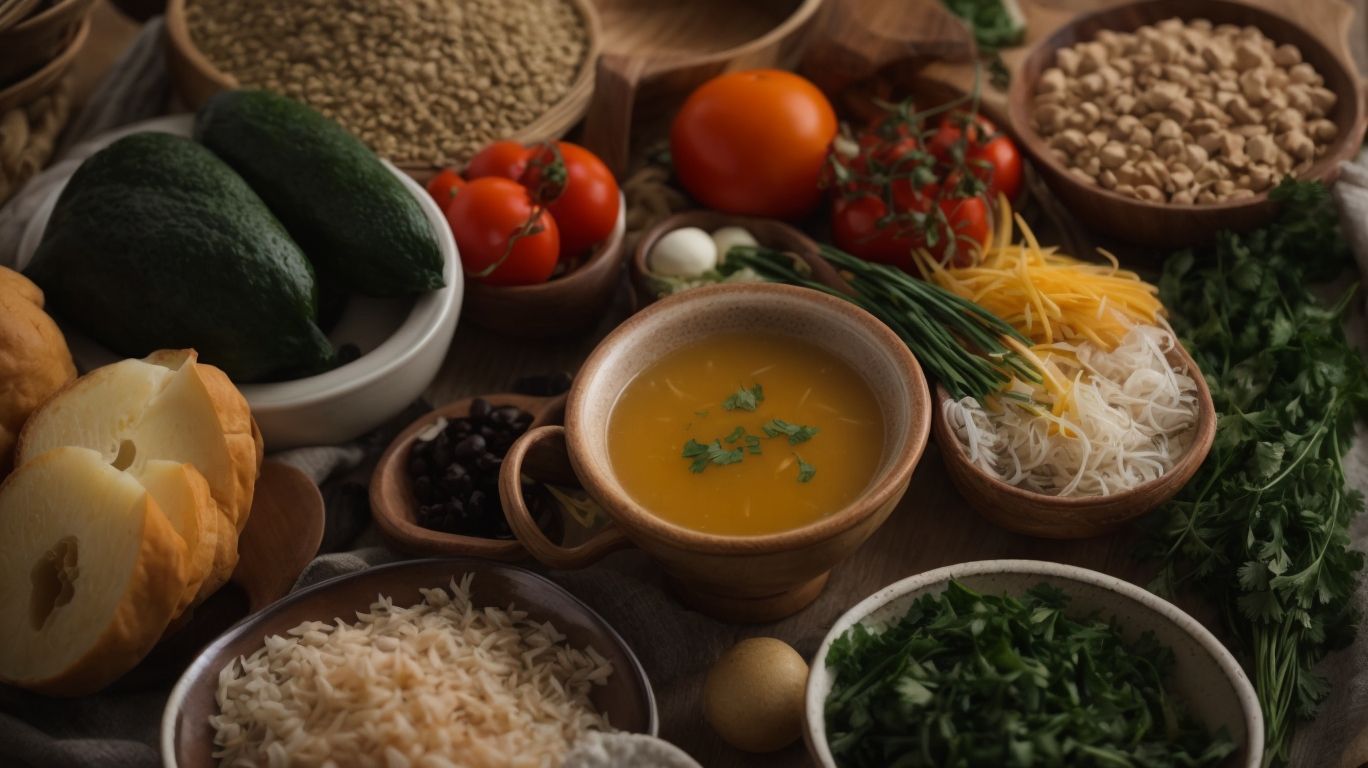How to Cook Oha Soup With Uziza and Achi?
Looking to add a flavorful and nutritious dish to your recipe repertoire? Look no further than Oha Soup with Uziza and Achi!
This traditional Nigerian soup is packed with rich flavors and unique ingredients like Oha leaves, Uziza leaves, and Achi.
We’ll walk you through the ingredients needed and provide step-by-step instructions on how to prepare this delicious soup. Plus, we’ll share some tips to help you cook the perfect Oha Soup every time. Let’s get cooking!
Key Takeaways:
What are the Ingredients for Oha Soup with Uziza and Achi?

Credits: Poormet.Com – Noah Anderson
Oha Soup with Uziza and Achi requires a blend of essential ingredients that include Oha and Uziza leaves, Achi, various meats like beef, chicken, or goat, stockfish, dry fish, palm oil, and seasonings like salt, pepper, and Maggi.
These ingredients come together harmoniously to create a rich and aromatic dish. The Oha leaves, known for their slightly bitter taste, add a distinctive earthy flavor to the soup. Uziza leaves, on the other hand, provide a peppery kick that elevates the overall taste profile.
Achi, a thickener derived from the Ogbolo tree, enriches the soup with its unique texture and nutty undertones. The combination of meats, such as beef, chicken, or goat, adds layers of depth and richness to the broth, while stockfish and dry fish contribute a delicious umami flavor.
The palm oil not only gives the soup its characteristic red hue but also imparts a subtle fruity flavor that enhances the dish. Seasonings like salt, pepper, and Maggi bring balance and depth, tying all the flavors together seamlessly.
Oha Leaves
Oha leaves are a key component in Oha Soup, providing a distinct flavor profile and nutritional value to the dish.
Known for their slightly bitter taste and aromatic scent, Oha leaves add a unique earthy depth to the soup. These dark green leaves are rich in essential nutrients like vitamins A and C, iron, and fiber, making them a healthy choice for enhancing the nutritional content of the dish.
When preparing Oha Soup, the leaves are typically shredded into thin strips to release their flavors. They are then added to the soup towards the end of cooking to preserve their delicate taste and texture.
In traditional Nigerian cuisine, Oha Soup holds cultural significance, often served during special occasions and celebrations, showcasing the importance of Oha leaves in culinary traditions.
Uziza Leaves
Uziza leaves add a unique and aromatic flavor to Oha Soup, enhancing its overall taste and aroma.
These leaves are known for their peppery taste and slightly citrusy aroma, which sets them apart from other traditional Nigerian herbs. When added to Oha Soup, Uziza leaves infuse a tantalizing spiciness that complements the rich, earthy flavors of the soup.
Their versatility extends beyond just Oha Soup as they are also used in various Nigerian dishes, such as pepper soups, stews, and sauces. The distinct notes of Uziza leaves provide a depth of flavor that elevates the culinary experience, making them a prized herb among West African cooks.
Achi
Achi serves as a natural thickener in Oha Soup, imparting a smooth and velvety consistency to the dish.
Oha Soup, a traditional Igbo delicacy, relies on the properties of Achi to create a rich and satisfying texture. To prepare Achi before adding it to the soup, it is first ground into a fine powder from the seeds of the African yam bean. When simmered in the soup, Achi not only thickens the liquid but also releases a subtle nutty flavor that enhances the overall taste profile. The use of Achi in Oha Soup respects the cultural heritage of Igbo cuisine, where each ingredient plays a crucial role in the recipe.
Meat (Beef, Chicken, or Goat)
The choice of meat, whether beef, chicken, or goat, adds protein-rich elements and distinct flavors to Oha Soup, catering to different preferences.
Selecting the right type of meat can significantly impact the taste and overall quality of Oha Soup. Beef, known for its rich and hearty flavor, complements the earthy undertones of the soup. On the other hand, chicken offers a lighter and more delicate taste, perfect for those looking for a milder flavor profile. Goat meat, with its unique gamey taste, adds depth and complexity to the dish.
In terms of cooking methods, each type of meat requires specific techniques to achieve optimal results. Beef is typically stewed slowly to tenderize the meat and allow the flavors to meld together, resulting in a robust and savory broth. Chicken, on the other hand, can be boiled or grilled before being added to the soup, retaining its tender texture and subtle taste.
Goat meat, being slightly tougher compared to beef and chicken, benefits from prolonged cooking times to ensure tenderness. Slow-cooking goat meat also helps to enhance its distinctive flavor, infusing the soup with a rich and gamey essence that elevates the overall culinary experience.
Stockfish
Stockfish brings a rich umami flavor and unique texture to Oha Soup, enhancing its depth of taste.
One of the key reasons why stockfish is highly valued in Oha Soup is due to its ability to infuse a rich umami flavor that complements the traditional ingredients of the dish. The process of incorporating stockfish into the soup involves rehydrating the dried fish in water until it softens, allowing it to release its intense savory notes into the broth.
The unique texture of stockfish adds a delightful chewiness to the soup, creating a contrast with the tender vegetables and meats commonly found in Oha Soup. This textural element not only enriches the overall mouthfeel but also provides a satisfying eating experience for those enjoying the dish.
Dry Fish
Dry fish contributes a savory and smoky essence to Oha Soup, enriching its overall aroma and taste.
There are several varieties of dry fish commonly used in Oha Soup, such as stockfish, catfish, tilapia, or mackerel. Each type adds a unique flavor profile to the dish.
To incorporate dry fish into the soup, it needs to be properly cleaned and soaked to remove excess saltiness. Some recipes suggest frying the dry fish before adding it to the simmering pot of Oha Soup to enhance its flavor further. The fish slowly infuses into the rich broth, creating a depth of taste that is quintessential to this traditional Nigerian dish.
Palm Oil
Palm oil acts as the primary cooking fat in Oha Soup, providing a rich and distinct flavor to the dish.
In Nigerian cuisine, palm oil plays a pivotal role not only in flavor but also in aesthetics. The vibrant red hue of palm oil adds a visual appeal to dishes like Oha Soup, elevating them to culinary art. Its unique taste infuses a depth of flavor that is quintessential to traditional Nigerian dishes, setting them apart from others. The rich, earthy notes of palm oil complement the bitterness of Oha leaves perfectly, creating a harmonious balance of flavors.
Seasonings (Salt, Pepper, Maggi)
Seasonings such as salt, pepper, and Maggi are essential for balancing the flavors and enhancing the taste of Oha Soup.
These seasonings play a crucial role in elevating the overall taste profile of the soup. Salt not only adds its own savory notes but also helps to amplify the other flavors present. Pepper brings a subtle heat that complements the earthy tones of the Oha leaves, while Maggi, with its umami richness, ties everything together.
When using seasonings in Oha Soup, it’s important to remember that a little goes a long way. It’s best to start with small amounts and gradually adjust to suit your preference. Properly seasoning the soup layers the flavors, creating a harmonious blend that delights the palate.
How to Prepare Oha Soup with Uziza and Achi?
The process of preparing Oha Soup with Uziza and Achi involves several steps, from prepping the ingredients to simmering the flavors to perfection.
Gather all the necessary ingredients:
- Oha leaves
- Palm oil
- Stockfish
- Crayfish
- Uziza leaves
- Achi or cocoyam as thickeners
- Assorted meats
Next, wash the Oha leaves thoroughly and slice them thinly. Prepare the Uziza leaves by shredding them finely.
In a pot, combine palm oil, stockfish, crayfish, and assorted meats, and let them simmer until the flavors meld together. Add the shredded Uziza leaves for an aromatic touch.
Then, add the cocoyam paste to thicken the soup to your desired consistency. Gently stir in the sliced Oha leaves and simmer for a few more minutes before serving hot. Bon appétit!
Step 1: Preparing the Meat and Stockfish
The initial step in making Oha Soup is preparing the meat and stockfish, ensuring they are cleaned, cut, and ready to impart their flavors into the dish.
In terms of cleaning the meat and stockfish, it is essential to wash them thoroughly to remove any impurities that can affect the taste of the soup. Proper cleaning ensures that the flavors are pronounced and not overpowered by any unwanted elements. For the stockfish, soaking in warm water helps to soften it before cooking, enhancing its texture in the soup.
Step 2: Preparing the Oha and Uziza Leaves
The next step involves preparing the Oha and Uziza leaves, washing them thoroughly and slicing them to the desired size for incorporation into the soup.
When handling these traditional Nigerian ingredients, it’s essential to start by gently rinsing the leaves under cool running water to remove any dirt or impurities. This step helps ensure that the flavors remain pure and the final dish tastes authentic.
Once cleaned, carefully stack the leaves on top of each other. Using a sharp knife, make precise cuts to achieve a uniform size, maintaining the integrity of the leaves for an appealing presentation in the Oha Soup.
Oha and Uziza leaves play a vital role in Nigerian cuisine, not only adding a delightful earthy flavor but also contributing significant nutritional value.
Step 3: Making the Achi Paste
Creating a smooth and well-mixed Achi paste is crucial in achieving the desired thickness and texture of Oha Soup, requiring careful blending and incorporation.
To start, soak the Achi seeds in warm water for about 30 minutes to soften them for easier blending. Once softened, drain the water and blend the seeds into a fine powder using a high-speed blender or food processor.
When blending, make sure to pulse in short bursts to prevent the paste from becoming too sticky or clumpy. Gradually add small amounts of water while blending to achieve a creamy consistency.
The Achi paste acts as a natural thickening agent for Oha Soup, giving it a rich and hearty texture. To enhance its thickening properties, simmer the soup gently after adding the paste, stirring constantly to avoid lumps.
For the perfect Oha Soup consistency, aim for a smooth, velvety texture with a slightly thickened base that coats the back of a spoon. Adjust the amount of Achi paste based on your desired thickness, ensuring a well-balanced and flavorful dish.
Step 4: Cooking the Soup
The final step involves cooking the soup, where all the prepared ingredients are combined, simmered, and seasoned to create a flavorful and aromatic Oha Soup.
Once all the ingredients are in the pot, it’s time to bring the soup to a gentle simmer. This allows the flavors to meld together beautifully. Stir occasionally to ensure even cooking and distribution of the ingredients. As the soup simmers, the aroma of the Oha leaves and spices will fill your kitchen, creating a delightful anticipation for the finished dish. Remember to taste the soup and adjust the seasoning as needed to achieve the perfect balance of flavors. Allow the soup to simmer for a while longer to deepen the flavors before serving hot and fresh!
Tips for Cooking the Perfect Oha Soup
Mastering the art of cooking Oha Soup to perfection requires attention to detail and adherence to certain tips and tricks that elevate the dish to new levels of taste and flavor.
When selecting ingredients for Oha Soup, opt for fresh oha leaves, stockfish, cow tripe, assorted meats, crayfish, seasoning cubes, and palm oil for an authentic taste.
To enhance the flavor, consider adding a touch of uziza leaves or scent leaves for a unique twist.
When cooking, ensure to simmer the ingredients slowly to allow the flavors to meld together harmoniously.
Adjust the seasoning to your preference by gradually adding salt and pepper, tasting as you go.
Serve your Oha Soup piping hot alongside fufu, pounded yam, or rice for a delightful and satisfying meal.
Use Fresh Ingredients
Using fresh and high-quality ingredients is paramount in ensuring the authenticity and deliciousness of Oha Soup, enhancing its overall taste and nutritional value.
In terms of Oha Soup, the quality of the ingredients directly impacts the final outcome. Fresh vegetables like Oha leaves, cocoyam, stockfish, and assorted meats play a crucial role in elevating the flavors and textures of this traditional Nigerian dish.
Choosing the finest ingredients ensures that the soup is bursting with rich flavors and maintains its distinct aroma. For example, ripe red palm oil adds a vibrant color and distinctive taste, enhancing the overall appeal of the dish.
Don’t Overcook the Oha Leaves
To preserve the vibrant color and delicate flavor of Oha leaves, it is crucial not to overcook them during the soup preparation process.
Overcooking Oha leaves can not only result in a loss of their vibrant green color but also lead to a mushy texture and a bland taste in the soup. To maintain the freshness of Oha leaves, it is recommended to cook them for no longer than a few minutes after adding them to the soup. This ensures that the leaves retain their distinct flavor and nutritional benefits.
One effective way to check if the Oha leaves are cooked to perfection is to look for a slight wilt in their texture without losing their bright green hue.
Adjust the Seasonings to Your Taste
Seasonings play a pivotal role in Oha Soup, and adjusting them according to personal preferences ensures a customized and satisfying flavor profile.
In terms of flavor balancing, Oha Soup offers a dynamic playground for experimentation. The delicate balance between the bitter oha leaves, the earthy aroma of dried crayfish, and the fragrant taste of utazi leaves requires careful consideration. To enhance the overall depth of the dish, tweaking the spice levels can elevate the experience. Individuals can cater to their unique taste preferences by gradually incorporating seasoning adjustments and tasting along the way.
Serve Hot with Your Choice of Swallow
For a complete and traditional experience, serve the piping hot Oha Soup with your preferred choice of swallow, enhancing the meal’s satisfaction and authenticity.
To create a perfect pairing, consider serving Oha Soup with Fufu, Eba, or Pounded Yam. These popular Nigerian swallows complement the rich flavors of the soup and offer a balanced meal. For a visually appealing presentation, garnish the Oha Soup with fresh pieces of goat meat or stockfish. Adding a touch of fresh palm oil not only enhances the taste but also adds a vibrant color to the dish, reflecting the cultural significance of Nigerian cuisine. Remember, in Nigerian traditions, meals are more than just sustenance; they are a celebration of flavor and community.
Frequently Asked Questions
What are the ingredients needed to cook Oha Soup with Uziza and Achi?
The ingredients needed for this soup include Oha leaves, Uziza leaves, Achi powder, beef or any protein of your choice, stockfish, smoked fish, crayfish, palm oil, onions, seasoning cubes, and salt.
Can I use frozen Oha and Uziza leaves for this recipe?
Yes, you can use frozen Oha and Uziza leaves for this soup. Just make sure to thaw them before using and squeeze out any excess water.
What is the best method to prepare the Oha and Uziza leaves for the soup?
To prepare the Oha and Uziza leaves, wash them thoroughly and chop them into small pieces. Then, place them in a pot of boiling water for 5 minutes before draining and adding to the soup.
Do I have to use Achi powder or can I substitute it with another thickener?
Achi powder is the traditional thickener used in Oha soup, but you can substitute it with cocoyam powder or cornstarch if desired.
Can I make this soup vegetarian?
Yes, you can make this soup vegetarian by omitting the meat and using vegetable broth instead. You can also add extra vegetables like mushrooms or tofu for protein.
How long does it take to cook Oha Soup with Uziza and Achi?
It takes about 45 minutes to 1 hour to cook this soup. However, if you are using tougher cuts of meat, it may take longer, so make sure to adjust the cooking time accordingly.






